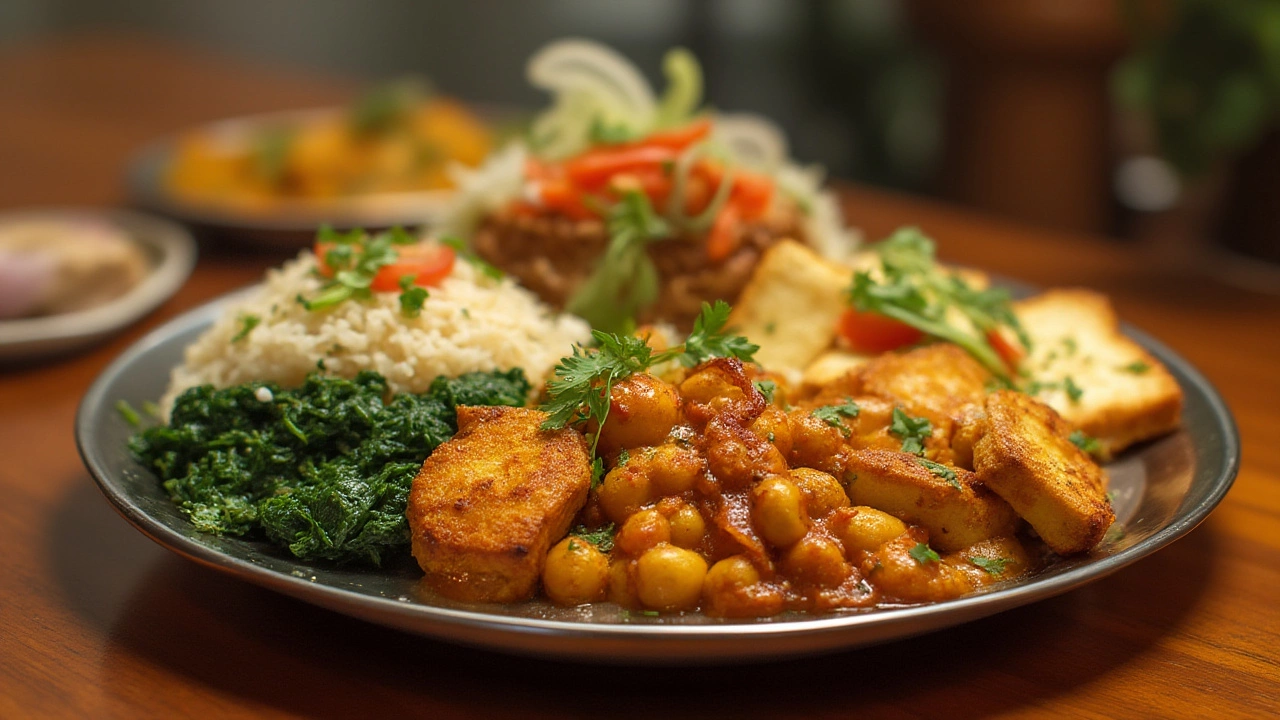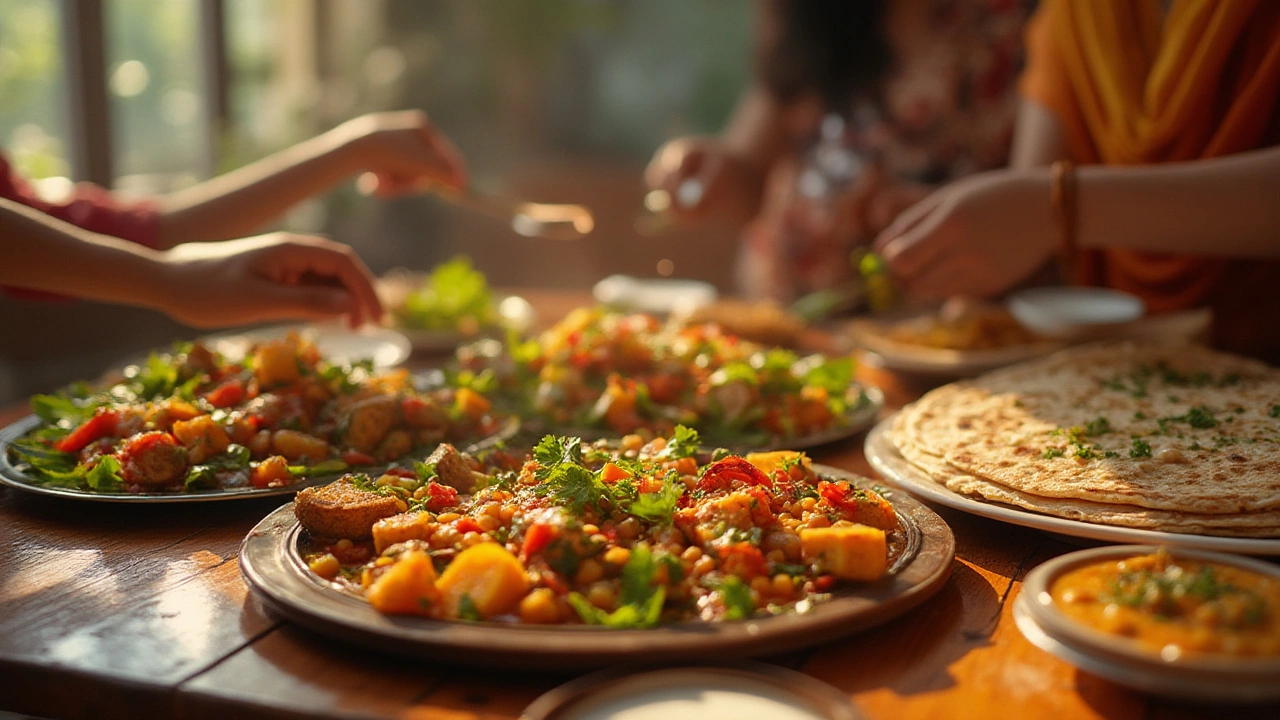17 Jul 2025
- 0 Comments
You’d think Indian food is all heavy curries and cheesy naans, right? That’s what I assumed the first time I sat at an Indian restaurant staring at a menu longer than a short novel. Turns out, Indian cuisine is packed with options so fresh and wholesome, you could actually walk out feeling lighter but satisfied. You just need to know what to look for, and a few smart tricks. Indian restaurants are a treasure chest for people who want to eat healthy without falling into another plain salad rut. Let’s step past the butter-laden clichés and unlock what’s truly good for you.
Why Indian Food Has a Healthy Edge
It’s easy to get overwhelmed by rich gravies and fried snacks, but Indian food draws its roots from Ayurvedic traditions, placing a huge emphasis on balance, plant-based eating, and using spices that do more than just add flavor. Did you know that traditional Indian meals are actually built around vegetables, lentils, and grains? The New England Journal of Medicine published a review in 2023 about traditional Indian diets showing they’re rich in fiber, antioxidants, and healthy plant compounds that reduce inflammation and heart disease risks. (My nerdy side swooned at the stat that a typical dal dish delivers more dietary fiber per serving than a whole wheat sandwich!)
Spices aren’t just for taste — turmeric helps with inflammation (curcumin is basically the superhero of spices), cumin aids digestion, and coriander can lower blood sugar. Unlike bland steamed veggies, Indian food unlocks deep flavors without needing cream or cheese for satisfaction. Home kitchens often balance five or six tastes in one plate, making it easier to stay full and happy on fewer calories. But let’s get real: restaurant menus often adapt these classics for international palates, piling on cream, butter, and oils. So which dishes keep the best of Indian health wisdom, without the high-calorie restaurant twist?
Smart Starters: Skip the Fryer, Embrace Fresh
Skip the temptation of those crispy samosas or pakoras. While they are delicious, one samosa can have over 250 calories and hefty saturated fat. Instead, look for starters like tandoori options, or salads with a lemon or yogurt dressing. Tandoori means food is marinated in spices and cooked in a clay oven, not fried, which keeps oil to a minimum. Tandoori chicken, fish, shrimp, or even vegetables have all that smoky flavor without the heavy oil.
If you see a chaat section, zero in on bhel puri or sprouted moong chaat. Bhel puri mixes puffed rice, tomatoes, onions, and fresh herbs in spicy tamarind dressing — pretty much a zesty Indian salad. Sprouted moong chaat is a protein bomb with a burst of freshness from lime, onions, and tomatoes. Dahi papdi chaat and samosa chaat sound lighter (those yogurt and chutney toppings!), but the papdi and samosa are fried, so you’re better off with moong or bhel.
- Best healthy starters: Tandoori platter (chicken/fish/paneer/vegetables), Sprouted moong chaat, Bhel puri, Tomato-onion-cucumber salad with lemon, Rasam (a tangy South Indian soup)
- Best to avoid: Samosa, Pakora, Paneer tikka if loaded with cream, Fried bhajiyas, Butter-slathered garlic naan as a starter
Now if you want soup, tomato shorba or rasam are low-calorie, bursting with tang and spice, and both easy on the gut.
Main Courses That Keep You Energized
Here’s where people trip up the most. Butter chicken, tikka masala, or paneer makhani seem like classic choices, but these often contain heavy cream, butter, and lots of oil. Even “vegetarian” can mean cheese cubes swimming in rich sauce (hello, paneer lababdar). The secret to eating healthy? Pick dishes where the actual hero is the lentil, vegetable, or lean protein, and the sauce is smartly spiced—not drowning in fat.
Dal tadka, dal palak, or chana masala are protein-rich, full of fiber, and really filling. According to a recent study by India's National Institute of Nutrition, a single cup of dal tadka with spinach has nearly 10g protein and only 170-200 calories, with most of the fat coming from a quick temper of spices at the end. Chole (chickpea curry) made without excess oil is another excellent pick, loaded with fiber and iron — key for vegetarians. Mixed vegetable curry isn’t just a jumble, but a rainbow of nutrient-dense veggies.
If you crave meat, tandoori chicken or fish tikka are my go-tos for lean protein. They’re cooked at high heat, so the fat drips away, and the spices add a punch of flavor. Avoid anything labeled “malai” (means “cream”), “makhani” (butter), or “korma” (nuts and cream). These might taste heavenly, but let’s be honest, you’d feel like taking a nap right after.
| Dish | Typical Calories/Serving | Main Benefits |
|---|---|---|
| Dal Tadka | 175 | Protein, fiber, iron |
| Chana Masala | 210 | Protein, fiber, B vitamins |
| Tandoori Chicken | 260 | Lean protein, low fat |
| Baingan Bharta (eggplant mash) | 170 | Antioxidants, potassium |
| Bhindi Masala (okra fry) | 180 | Fiber, vitamin C |
Baingan bharta (roasted eggplant mash) is another secret weapon. It’s packed with antioxidants, low in oil, and full of comforting flavors. For dry sautéed choices, go for aloo gobi (potato-cauliflower), bhindi masala (okra), or cabbage sabzi — all loaded with vitamins and light on the stomach.

Your Bread and Rice Choices: Don’t Sabotage Your Plate
Bread and rice often turn a healthy meal into a carb overload. But here’s the trick: choose whole wheat or millet breads over the fluffy naan. Roti, phulka, and jowar or bajra rotis are the best picks, because they’re made with whole grains. Ask for them dry, without butter or ghee. Steer clear of buttery naan or parathas, which sometimes have more fat than your main dish.
For rice, go with plain basmati or brown rice — not pulao, biryani, or fried rice. Basmati has a lower glycemic index than other rice, meaning it won’t spike your blood sugar as much. If you see “jeera rice” (cumin rice), that’s usually just plain rice with a cumin temper. Skip anything “fried” or with lots of nuts and raisins (those rarely add nutrition, just candy-level calories).
- Best breads: Whole wheat roti, phulka, jowar (sorghum) roti, bajra (millet) roti
- Best rice options: Brown rice, steamed basmati rice, jeera rice
- Avoid: Naan (with or without garlic), lachha paratha, stuffed kulcha, fried rice, biryanis with cream/oil
If you’re sharing with friends, split a serving of rice or bread among two, and load up more on the protein veg dishes to keep your meal lighter.
How to Order: Healthy Hacks and Tips
Ordering Indian food can feel like a test. Here are hacks I’ve used when eating out with Oliver, my husband, especially when we both want to leave the table energized for a long walk instead of reaching for elastic waistbands.
- Ask for less oil and butter. Most kitchens are happy to dial it back if you ask upfront; just say, “No ghee/butter in my curry and breads, please.”
- Choose grilled, roasted, or steamed. If the menu says tandoori, roasted, steamed, or sautéed — you’re safe. Fried, creamy, or buttery? Danger zone.
- Skip the heavy desserts. Gulab jamun, ras malai, and gajar halwa are delicious but packed with sugar and fat. Fresh fruit or a small bowl of plain yogurt (curd) is the light way out.
- Look for South Indian mains for variety. Dishes like sambar (lentil-vegetable stew) with idli (steamed rice cakes), or plain dosa (fermented rice-lentil crepe) with coconut chutney are fabulous for breakfast, lunch, or dinner — light but super filling and gut-friendly. One average dosa packs under 170 calories, mostly from complex carbs, and sambar is loaded with fiber and protein. Just skip the ghee roast varieties or masala dosa if you’re counting calories.
- Add extra veggies or salads on the side. Indian restaurants often have cucumber-tomato-onion salads or plain steamed veggies — order them! They help fill you up without many calories or much fat.
- Pick yogurt-based sides. Try a bowl of raita (yogurt with cucumber or boondi), which helps with digestion and cools down the spices. Avoid the creamy lassi shakes if you want to keep calories low.
- Watch hidden sugars. Some curries add sugar or condensed milk for sweetness; just ask if the curry has sugar, and most places will leave it out if you ask.
- Control portions. Restaurant servings are huge. Take half home, or share dishes, so you eat until satisfied but not too stuffed.
- Be spice-wise. Higher spice often means the chef uses less fat. If you can handle spice, ask them to go medium or hot — more chili, less oil.
As a tip, most Indian meals come with pickles and papad, but skip the non-stop nibbling on these. Indian pickles are delicious but super salty and oily, and papad is often fried.
Hidden Stars and What to Absolutely Try
Healthy Indian food doesn’t have to be boring and brown. Dishes like palak paneer (spinach with paneer) can be excellent if the chef cuts down cream — ask for it “without cream or butter.” Karela sabzi (bitter gourd stir fry) and lauki chana dal (bottle gourd with split chickpea) sound plain but are home-cooked staples known for lowering blood sugar and being packed with nutrients. Tomato-based curries like bhindi masala and baingan bharta rely on slow-roasting and robust spice blends instead of fat.
And don’t ignore the ordinary-looking dal. In Punjabi kitchens, simple dal tempered with cumin and garlic is the comfort food of choice. A small plate of roasted papad on the side or a wedge of lime is all it needs.
Feeling adventurous? Try millet khichdi (porridge with grains and lentils), especially if it’s on a lunch platter. The World Health Organization lists Indian millet grains as one of the top superfoods for fiber and micronutrient density since most urban diets lack enough whole grains. Regional specialties like Sol kadhi (coconut and kokum drink from Maharashtra) and vegetable stew with appam (Kerala rice pancakes) sneak in extra vitamins and probiotics while keeping flavors bright.
When you order healthy Indian food, you’re signing up for more than “less fat.” You’re saying yes to a world of spices, ancient food wisdom, and dishes that really nourish your body. Next time you open a menu, grab a tandoori platter, load up on dal and veggie curries, and finish with a cooling bowl of raita. Your taste buds (and your gut) will thank you — and you’ll probably wake up the next day feeling lighter, not weighed down.
